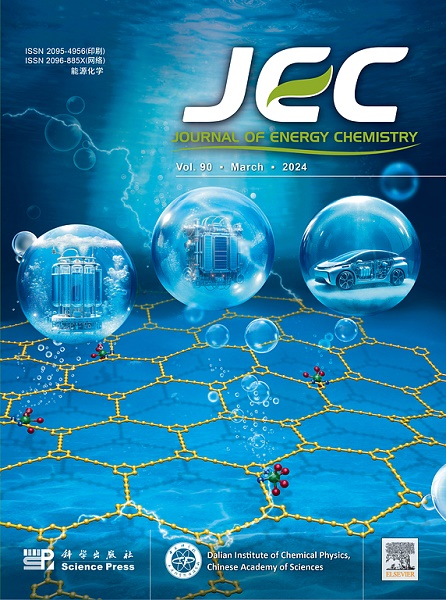A low-cost and high-energy aqueous potassium-ion battery
IF 13.1
1区 化学
Q1 Energy
引用次数: 0
Abstract
To address challenges related to the intermittency of renewable energy sources, aqueous potassium-ion batteries (AKIBs) are a promising and sustainable alternative to conventional systems for large-scale energy storage. To enable their practical application, maximizing energy density and longevity while minimizing production and material costs is a key goal. In this work, we propose an AKIB consisting only of abundant and cost-efficient materials, which delivers a high energy density of more than 70 Wh kg−1. We combine simple strategies to stabilize the Mn-rich Prussian blue analog cathode by Fe-doping, improving the crystallinity, and tuning the electrolyte composition without employing expensive water-in-salt electrolytes. Using a mixed 2.5 M Ca(NO3)2 + 1.5 M KNO3 electrolyte, we assemble a novel AKIB with a Fe-doped manganese hexacyanoferrate cathode and an organic poly(naphthalene-4-formyl-ethylenediamine) anode. Besides a high energy density, the full cell delivers a specific capacity of approximately 60 mA h g−1, a power density of 5000 W kg−1, and 80% capacity retention after 600 cycles.

一种低成本、高能量的钾离子电池
为了解决与可再生能源间歇性相关的挑战,水钾离子电池(akib)是传统大规模储能系统的一个有前途和可持续的替代方案。为了使其实际应用,最大限度地提高能量密度和寿命,同时最大限度地降低生产和材料成本是一个关键目标。在这项工作中,我们提出了一种仅由丰富且具有成本效益的材料组成的AKIB,其能量密度超过70 Wh kg−1。我们结合简单的策略,通过fe掺杂来稳定富锰普鲁士蓝模拟阴极,提高结晶度,调整电解质组成,而不使用昂贵的盐包水电解质。使用混合的2.5 M Ca(NO3)2 + 1.5 M KNO3电解质,我们组装了一种新型AKIB,其阴极是掺铁的六氰高铁酸锰,阳极是有机聚萘-4-甲酰基-乙二胺。除了高能量密度外,该电池的比容量约为60 mA h g−1,功率密度为5000 W kg−1,经过600次循环后容量保持率为80%。
本文章由计算机程序翻译,如有差异,请以英文原文为准。
求助全文
约1分钟内获得全文
求助全文
来源期刊

Journal of Energy Chemistry
CHEMISTRY, APPLIED-CHEMISTRY, PHYSICAL
CiteScore
19.10
自引率
8.40%
发文量
3631
审稿时长
15 days
期刊介绍:
The Journal of Energy Chemistry, the official publication of Science Press and the Dalian Institute of Chemical Physics, Chinese Academy of Sciences, serves as a platform for reporting creative research and innovative applications in energy chemistry. It mainly reports on creative researches and innovative applications of chemical conversions of fossil energy, carbon dioxide, electrochemical energy and hydrogen energy, as well as the conversions of biomass and solar energy related with chemical issues to promote academic exchanges in the field of energy chemistry and to accelerate the exploration, research and development of energy science and technologies.
This journal focuses on original research papers covering various topics within energy chemistry worldwide, including:
Optimized utilization of fossil energy
Hydrogen energy
Conversion and storage of electrochemical energy
Capture, storage, and chemical conversion of carbon dioxide
Materials and nanotechnologies for energy conversion and storage
Chemistry in biomass conversion
Chemistry in the utilization of solar energy
 求助内容:
求助内容: 应助结果提醒方式:
应助结果提醒方式:


